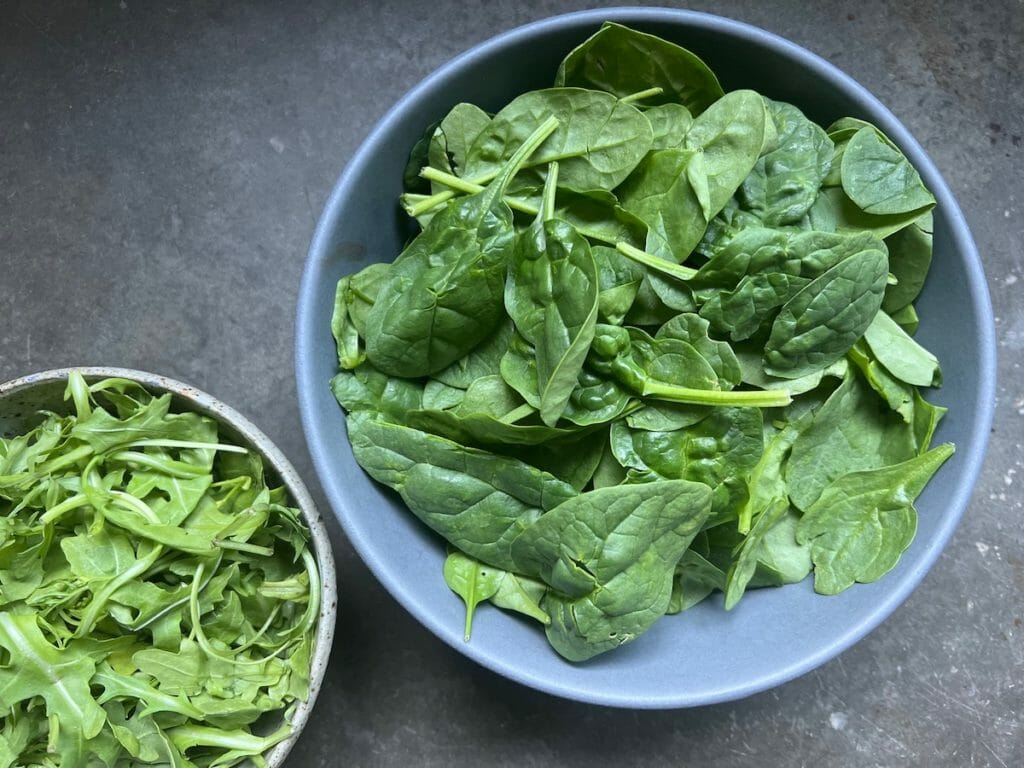Unless you’ve been living in a cave, it would be impossible to miss the memo that leafy greens are good for you. Most of us have known this simple fact since we were kids, either from parents advising us to eat our collards or Popeye showing off the power of spinach. And even if you’ve known it to be true, you may have wondered about the benefits of dark leafy greens and how to add them to your diet.
What Are Leafy Greens?
There may not be an official definition for dark leafy greens, but the dietitian in me has a pretty good grip on what that means. I consider this a broad category of leafy vegetables that are vibrant green and packed with nutrients. The ones that come to mind include:
- Kale
- Spinach
- Collard Greens
- Arugula
- Turnip tops
- Beet greens
- Mustard greens
- Dandelion greens
- Watercress
Why are Dark Leafy Greens so Healthy?
Dark leafy greens are a notably nutrient-dense group of vegetables. That means they’re very rich in vitamins, minerals, and other nutrients, particularly in relation to how low in calories they are. Translation: you get a huge bang for your buck. Consider, for example, that 1 cup of chopped raw kale weighs in at just 33 calories, but delivers whopping doses of vitamins A, K, and C, plus a whole cocktail of disease-fighting phytochemicals. Research has found leafy greens associated with a decreased risk for cancer, diabetes, cognitive decline, and heart disease, as well as improved muscle strength and speed.
Every green in this leafy group has a different nutrient profile and all have something to offer. Generally speaking, these leafy vegetables tend to be rich in vitamins A, C, E and K, along with B vitamins. Some of the benefits of dark leafy greens also include fiber, iron, magnesium, potassium, and calcium. Plus, greens can be an important source of folate, a B vitamin that can prevent birth defects. They’re also packed with antioxidants and other phytonutrients with anti-inflammatory upsides.
How Many Servings of Leafy Greens Each Day
It’s hard to say exactly how many servings of greens we should be eating for maximum health benefits. The USDA Dietary Guidelines recommend 2 to 3 cups of vegetables a day, which includes leafy greens. And while they advise 1 1/2 to 2 cups of dark greens a week, plenty of research suggests that may fall short. Proponents of the MIND diet, for example, recommend 1 serving of greens per day (1 cup raw, 1/2 cup cooked), which has been found to slow rates of cognitive decline. Other studies have shown that 2 to 3 servings per week may lower risk of certain cancers, and a recent study linked 1 cup of dark greens with decreased risk for heart disease. My take? I like to aim for 1 to 2 cups of leafy vegetables a day. Some days I exceed that amount, other days not so much. Over the course of a week, though, I hope to hit the mark. If you’re starting from zero, take it in small steps and set an achievable goal. Perhaps that means you target 1/2 cup a day or a few cups a week.
16 Recipes with Dark Leafy Greens
A key to getting in enough leafy greens is to keep them stocked, washed, and handy in the fridge. It’s easy to add a handful to smoothies, salads, stir fries, pasta sauces, and soups. And don’t overlook frozen greens, too. Spinach, collards, and kale from the freezer section are arguably as healthy as fresh.
Perhaps above all is that these vibrant vegetables add color, flavor, and interest to a wide variety of dishes. With that in mind, here are 16 recipes using dark leafy greens.
